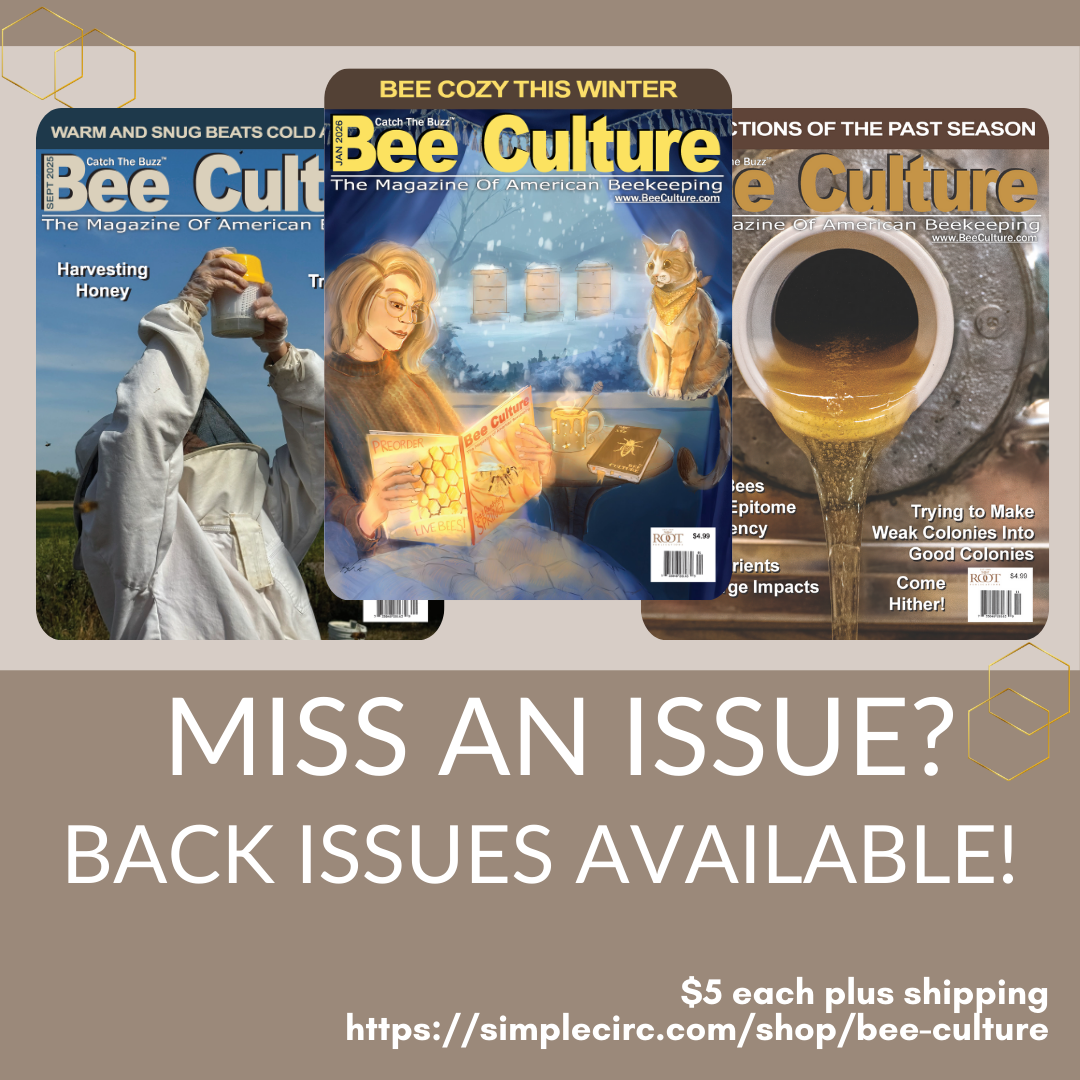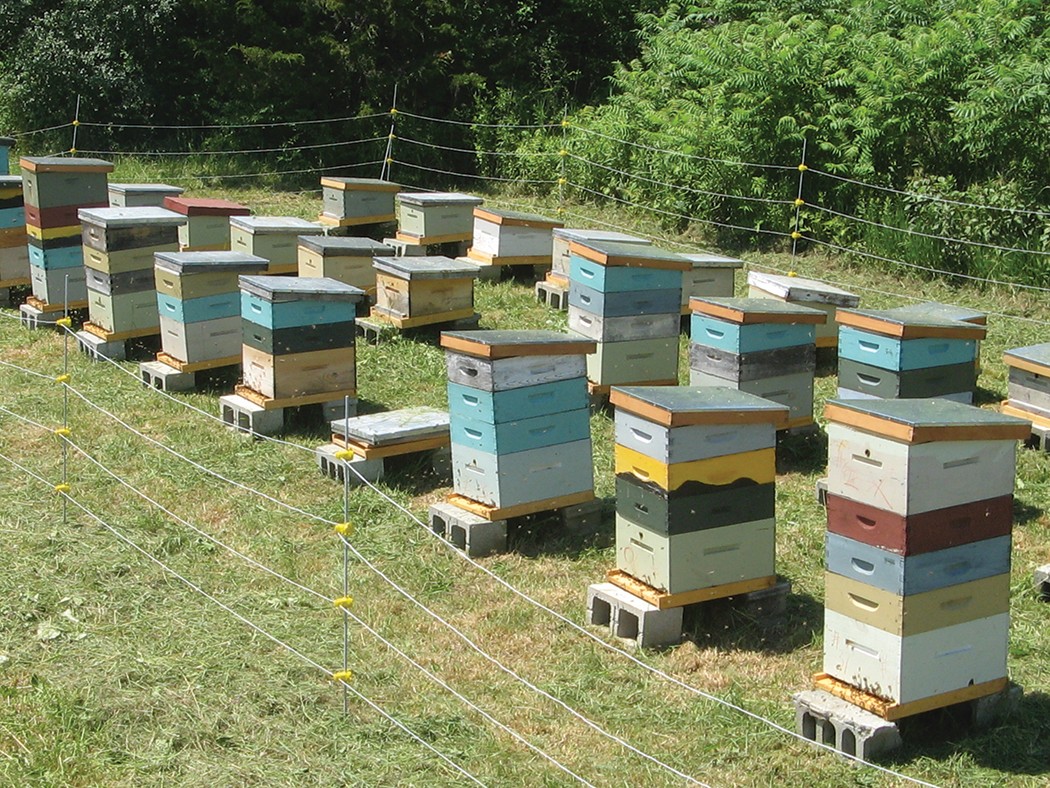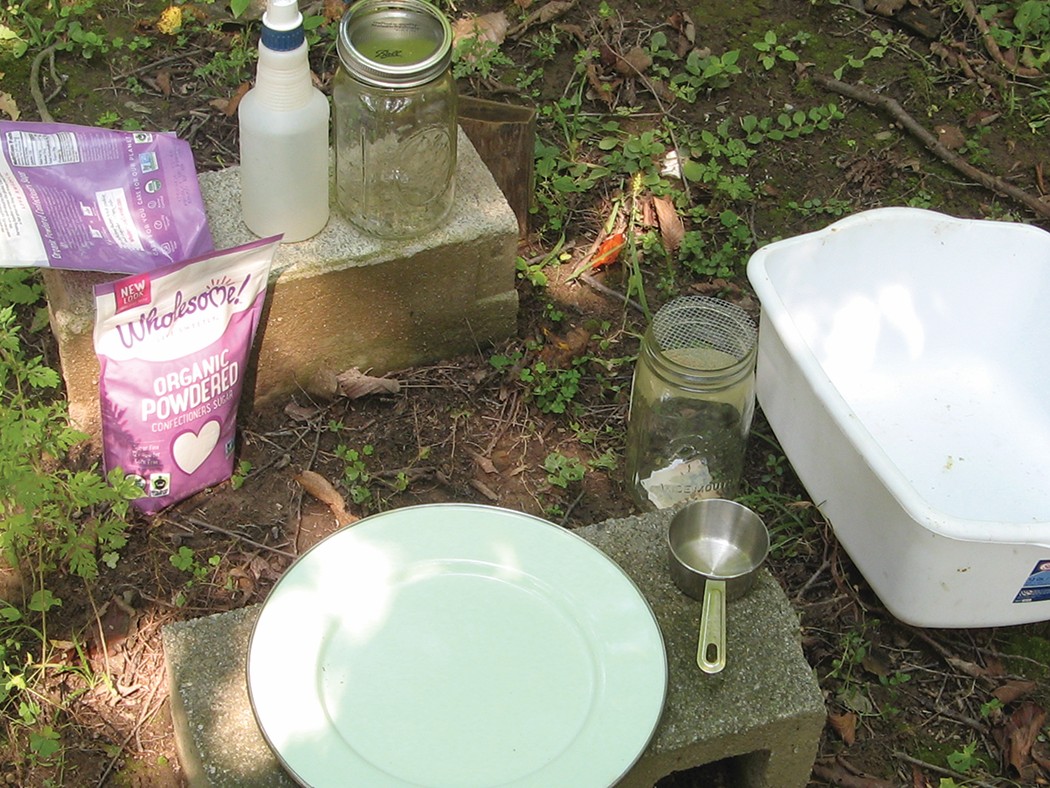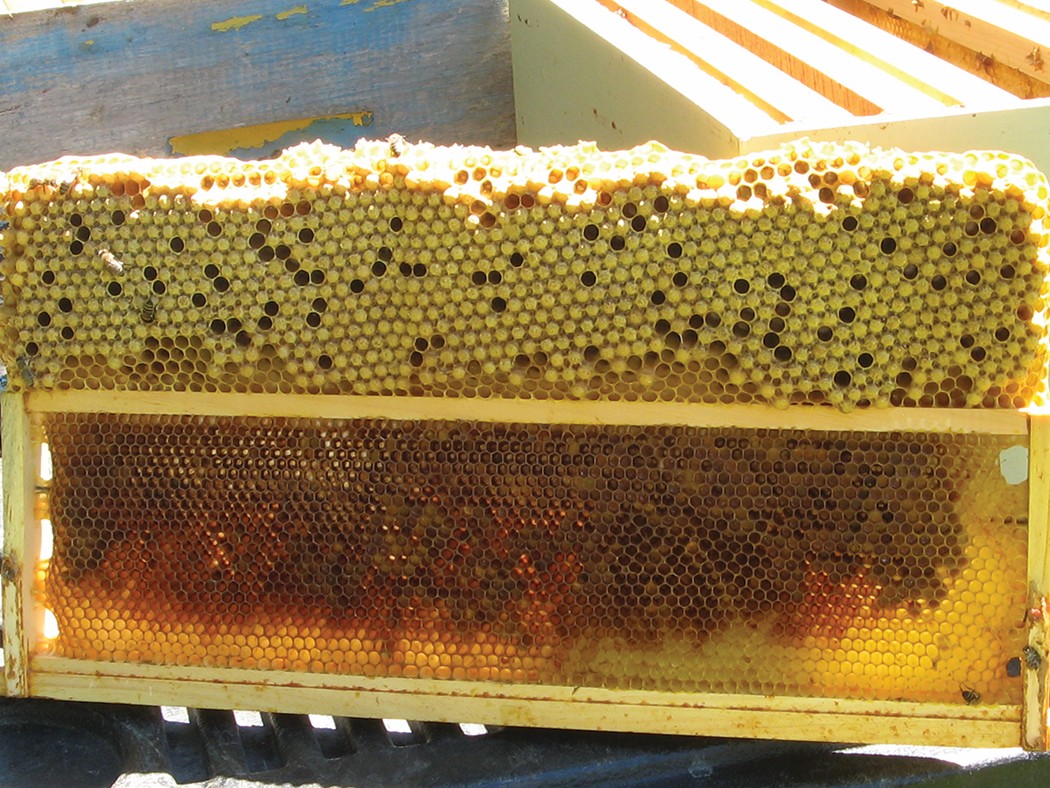Ross Conrad
ABSTRACT
The parasitic mite, Varroa destructor is the most widespread pest of the western honey bee, Apis mellifera. This mite reproduces in honey bee brood cells, so it parasitizes both immature and adult bees. The mite spreads pathogens throughout a colony’s population through its feeding behavior and is considered one of the leading causes of death in colonies of honey bees. While the beekeeping industry has turned primarily to the use of acaricides to control V. destructor, there is strong interest in developing methods of control that do not rely on chemical treatments. I evaluated two combinations of mechanical and cultural controls that have potential to lower Varroa mite (Varroa destructor) population levels and the damaging effects of related viral impacts. I hypothesized that such mechanical and cultural controls, when combined, may sustain the lives of colonies without the use of chemical treatments. I found that the combination of mechanical and cultural controls used in this trial controlled Varroa mites as effectively as a popular acaricide (Mite Away Quick Strips). By adopting these treatment-free mite management techniques, beekeepers can reduce, or potentially avoid, the need to apply acaricides to control Varroa mites.
INTRODUCTION
The ectoparasitic Varroa mite (Varroa destructor) is one of the primary challenges to today’s beekeepers (Rosenkranz et. al. 2010; Guzmán-Novoa, et. al. 2010). Varroa acts as a vector for viruses that can kill colonies (Ball & Allen 1988; Tentcheva, et. al. 2004; Chen et. al. 2006; Gisder et. al. 2009). Additionally the feeding by Varroa on the fat bodies of honey bees weakens their immune responses and renders them vulnerable to pathogens and pesticides (Yang & Cox-Foster 2005; Ramsey et. al. 2019).
The beekeeping industry initially turned to synthetic acaricides to control V. destructor and this has led to the evolution of resistance to these chemicals (Milani 1999; Elzen et. al. 2002; Rodríguez-Dehaibes, et. al. 2005). The use of acaricides in bee colonies also creates the potential for beeswax and honey contamination which can lead to unintended impacts on the bees (Orantes-Bermejo, et. al. 2010; Mullin et. al. 2010; Calatayud-Vernich, et. al. 2018).
Previous work suggests that the problems of pesticide-resistant mites and pesticide-contaminated hives may be avoided if beekeepers develop mechanical manipulations and cultural controls as part of an integrated pest management approach (Delaplane, et. al. 2005). Anecdotal reports indicate that treatment-free beekeepers have developed effective alternatives to acaricide use (Webster 2013; Conrad 2013). In this study, five mechanical and cultural control techniques were tested. The techniques tested combine the use of localized Varroa-tolerant honey bee stock, screened bottom boards, a break in the honey bee brood cycle, the regular culling of old comb, and the removal and destruction of capped drone brood. It was hypothesized that such simple and low-cost techniques, when used in combination, may sustain the lives of colonies without the use of chemical treatments. Long-term colony survival, honey production, and mite population levels were monitored over the course of the trial.
MATERIALS AND METHODS
In this study, forty five nucleus colonies of Russian-based, locally-raised stock bred for Varroa tolerance were purchased from Champlain Valley Bees and Queens of New Haven, Vermont. The colonies were divided into three groups of fifteen colonies each, and a fourth group of fifteen colonies was created from the treatment-free group in the beginning of the trial during the process of removing the queen, and frames of bees, brood, honey and pollen to create a brood break: (1) the group (TF) received the five above-mentioned mechanical and cultural control techniques, (2) the group (TFQ) created with the queens and bees from the TF group, received the above techniques but the queen was always left with the colony when bees and brood were removed to make a split without forcing a brood break, (3) the group (QS) received the commercial acaricide [Mite Away Quick Strip (MAQS), NOD Apiary Products], and (4) the control group which received no mite control management (C).
The five mechanical and cultural control techniques tested were:
1. Localized stock with a genetic predisposition for Varroa resistance – Utilization of innate genetic Varroa resistance of the honey bee is recognized as a potential long-term solution to the Varroa problem within the beekeeping industry (Harbo & Harris 1999, 2005). Strains of honey bees have been identified that exhibit levels of resistance to Varroa (Kurze et. al. 2016). Commercially available strains include Russian (Rinderer et. al. 2001, 2010), Hygienic (Boecking & Spivak 1999), Varroa sensitive hygiene (VSH) stock (Ibrahim & Spivak 2006; Panziera et. al. 2017) and mite biting bees (Hunt et. al. 2016). Locally raised honey bees also exhibit the potential for improved survival over bees imported from outside a region (Pinkiw 2003; Parker et. al. 2010, Hatjina et. al. 2014).
2. Screened Bottom Boards – Bottom boards outfitted with a screen have the potential to remove mites that are knocked off bees through honey bee grooming, or lose their grip and fall to the bottom of the hive (Webster et. al., 2000; Harbo & Harris 2004). Screened bottom boards are used to monitor natural mite fall to determine when treatments are necessary (by estimating Varroa populations), and test efficacy following treatments. While screened bottom boards have the capacity to remove a small percent of the phoretic mites (mites on bodies of bees) in a hive, it is not recognized as an effective control method for Varroa on its own (Rinderer et. al. 2003).
3. Interruption of brood cycle – The reproductive biology of Varroa is closely tied to the reproductive biology of the honey bee as young mites feed on the honey bee pupae and larvae during development. Successful mite reproduction requires mated female mites (foundress) to successfully raise a minimum of two offspring (one male and one female) inside brood cells. Each invading foundress can produce about 1.5 mated female offspring in worker cells and 2.7 in drones during a single honey bee brood cycle of 21-24 days (Fries et al. 1994; Martin 1998). Mite reproduction along with phoretic mites on foragers entering the hive (DeGrandi-Hoffman et. al. 2016) may lead to rapid V. destructor population growth within infested hives (Martin & Kemp 1997; Martin 1998). Interruption of the honey bee brood cycle and associated reduction of brood and colony size may be an adaptive strategy – limiting the reproductive cycle of V. destructor and decreasing the speed that mite populations can increase within a colony (Calis et al. 1999). Natural brood interruption occurs through the act of swarming which typically causes a loss of 40–70 % of the adult worker bee population along with many phoretic mites, followed by a broodless period when mite reproduction is restrained (Wilde et al. 2005). It has been suggested that colonies experiencing an interruption in the brood cycle have an increased capacity to survive Winter, compared to untreated hives that do not experience a similar break in brood rearing (Frey et. al. 2013).
4. Culling of old comb – Beeswax contains a large number of components and is primarily composed of esters of fatty acids and various long-chained alcohols which are fat-soluble (Piek 1964; Tulloch 1971). The lipophilic quality of beeswax results in the absorption and accumulation of petroleum-based environmental contaminants such as pesticides (Chauzat & Faucon 2007; Mullin 2010, Calatayud-Vernich, et. al. 2018). Beeswax combs may also accumulate honey bee pathogens over time (Katznelson et. al. 1952; De Guzman, et. al. 2019). Old combs with chemical and pathogen residues have sub-lethal impacts on the health and vitality of honey bee colonies (Yang and Cox-foster 2007; Wu et. al. 2011). It is theorized that honey bees exposed to multiple stressors are less able to handle the additional stress of Varroa infestation as compared to colonies with fewer stressors. This suggests that by reducing stress factors such as old pesticide and pathogen contaminated comb from a hive, honey bee colonies are more likely to survive the stress induced by Varroa mite infestation (Goulson, et. al. 2015). To reduce exposure to potential contaminants, beekeepers track the age of their frames of comb, and replace the oldest comb with frames of new wax foundation which the bees ‘draw out’ into fresh comb made of newly produced wax.
5. Culling of drone brood – Varroa mites demonstrate a reproductive preference for drones, and are able to raise a higher population of young on drone brood larvae compared to worker brood (Fuchs 1990; Boot et. al. 1992; Ghamdi & Hoopingarner 2003). Beekeepers encourage the construction of drone comb within hives by inserting into the brood nest frames of drone foundation, or short frames which encourage the colony to build drone comb in the empty space below the frame. By removing and destroying capped drone comb prior to emergence, significant numbers of reproductive Varroa can be removed from the hive (Calderone 2005; Wantuch & Tarpy 2009).
In the Spring of 2016, 45 nucleus colonies were purchased and divided into three groups of 15 colonies each.
- A cultural treatment group (TF) housed in hives containing a screened bottom board, frames of drawn comb a maximum of five-years old and drawn from small-cell comb foundation, or from one-inch strips of small cell foundation (4.9 mm). These colonies had three frames of bees, brood, honey, pollen and the queen removed each spring and were left to raise an emergency replacement queen forcing a break in the brood cycle. Colonies also received frames of drone foundation, or shallow frames in the deep hive body that was removed once filled and capped with developing drone brood.
- A cultural treatment group (TFQ) that was treated the same as the TF group except the queen was left in the hive when frames of bees, brood, honey, and pollen were removed each spring to create nucleus colonies.
- A treated group (QS) received the same treatment as the control group but were treated annually during the first half of September with a standard full application of Mite Away Quick Strip (MAQS) as directed by the label.
- A control (C) group outfitted with solid wood bottom boards and frames of beeswax comb that were between five- and 11-years old. The control group did not receive a forced break in the brood cycle, drone brood was not removed, and no acaracides were applied to this group.
Two apiary locations were established .75 miles from each other on the same farm. Group (C) was located in one of the apiaries and the other location contained a total of 30 hives: the 15 TF hives and 15 QS hives. A third apiary composed of the bees, queens, brood and food combs removed from the TF group during year one was established approximately 15 miles from the first two and composed the TFQ Group.
As colonies expanded during the season, all frames added to growing colonies consisted of either sheets of 4.9mm small cell beeswax foundation, comb drawn from small cell (4.9mm) foundation (Dadant & Sons, Hamilton, IL), or natural comb constructed by bees raised on small cell comb and given small cell beeswax or wooden starter strips (Dancing Bee Gardens, Middlebury, VT). Drawn comb used in the C and QS groups was a minimum of six years old while combs used in the TF and TFQ groups was a maximum of five years old.
All other management practices remained consistent across the four groups. Varroa mite population levels were monitored in Spring following successful natural requeening of the TF group. Mite populations were monitored again in late August/early September during the 2016-2018 seasons. Counts reflected in graph were taken after the QS group was treated with Mite Away Quick Strips for 14 days. Varroa levels in the QS group were also monitored immediately prior to treatment to confirm efficacy of treatment (not shown in graph). Mite monitoring was conducted using the sugar dusting method (Macedo & Ellis 2000, Aliano & Ellis 2005).
Honey supers harvested from all hives during late Summer were recorded during the study. Colonies were inspected regularly throughout the season for disease, viability of the queen and other health issues, and colony deaths were noted and recorded.
RESULTS
Varroa Loads: In 2016, for both Spring and Autumn sampling events, the Control group had the highest mite loads compared to the other groups (p < 0.001). In 2017, there were no differences between groups in the Spring (p > 0.068). However, in the Fall of 2017, the Control and TFQ groups had significantly higher mite loads compared to the QS and TF groups (p < 0.001). The QS treatment in the fall of 2017 had the lowest mite loads (p = 0.003). The Control group died in the Winter of 2017-2018 and was therefore omitted from subsequent data analyses. In the Spring of 2018, once again there was no difference between groups (p > 0.09). In the Fall of 2018, TFQ was significantly lower than QS (p = 0.02) and TF (p = 0.02). With the exception of TF in 2017 (p = 0.173), Varroa loads increased for all treatments in the Fall for every year of the study (p < 0.001).
Honey Production: In 2016, the Control group and QS group had the highest honey production compared to TF and TFQ (p = 0.0002). In 2017, QS had the highest honey production (p < 0.2) and TF had the lowest (p < 0.0005) and there was no difference in honey production between Control group and TFQ (p = 0.146). In 2018, QS had the highest honey production compared to TF and TFQ (p < 0.0001).
Survivorship: Five colonies in the TF group died in 2016 within the first two months of the trial (four failed to successfully raise a replacement queen following queen removal and one suffered a bad case of chalk brood and went queenless).
DISCUSSION
As expected given our knowledge of Varroa mite’s reproduction and life-cycle, each year varroa populations increased between Spring and Autumn in all hives and across all treatment groups. The treatment methods (TF, TFQ, and QS) were able to mitigate this increase in colony mite load, although to varying levels. A great example of this was in 2017 when all groups started the year with similar Varroa mite infestation levels.
The results support the hypothesis that when combined, the five cultural and mechanical mite control techniques utilized in this trial are capable of controlling mites and improving colony survival as well as a commercially available acaricide. Such methods when adopted may lead to lower acaracide use, and reduced chemical contamination of beeswax and honey. The trade-off is reduced honey production which was lower for both the TF and TFQ groups compared to the QS and C groups throughout the trial. This observation is likely a result of the slower worker population build up that both the TF and TFQ groups experienced due to mite control efforts that interrupt the brood cycle through splitting colonies. During the 2017 season, the similar honey production observed within the C group compared to the TFQ group was likely a product of the high mite populations experienced by the control colonies. This decrease in honey production combined with the increased labor required to implement cultural controls limit the usefulness of this approach to small-scale and backyard beekeepers.
The fact that the TFQ group experienced reduced survival compared to the TF group suggests that the impact on Varroa reproduction from a break in the brood cycle is an important cultural control that should not be underestimated when using treatment-free Varroa management, provided colonies are able to successfully raise a new queen. Compared to the other three groups, the decreased survival of the C group supports the findings of other studies that doing nothing to control Varroa mite populations results in poor outcomes primarily from virus infections. (Chen 2006)
An interesting finding was not just how well the various treatment groups survived, but the apparent causes of colonies death. One third of the colonies in the TF group died within the first two months of the trial and yet after 2½ years, the group’s overall survival rate was still comparable to the QS group. While the majority of the Control group colonies died during the winter months presumably from Varroa related issues, the majority of the QS colonies all died during the Summer by becoming queenless. While colonies were generally not requeened during the trial, two colonies (one in the QS group and one in the TFQ group) were manually requeened by the beekeeper when the colonies naturally became queenless and a queen from a captured swarm was available at the time.
The apiary containing the QS and the TF group was surrounded by commercially farmed GMO corn that utilized both neonicotinoid treated seed and glyphosate based herbicide during the course of each growing season and potential exposure to these pesticides may have played a role in the queen issues observed in the colonies located in this yard (Balbuena 2015, Wu-Smart and Spivak 2016, Chaimanee 2016, Brandt 2017). Pathogen and pesticide residue build up in the old combs used in both the QS and C groups are possible impacted survival. Potential pesticide related health issues were noted in the QS group during the course of the trial and in one case, a seemingly healthy colony collapsed (June-July 2018) and exhibited all the symptoms of Colony Collapse Disorder. (van Englesdorp et. al. 2007) This colony had a mite count of zero per 300 bee sample in June, had been building up well and had two and half supers of honey stored in the hive, but by mid-July it dwindled down to a handful of bees on three frames of brood, and died out before the end of July.
ACKNOWLEDGEMENTS
Special thanks to Samantha Alger, Plant and Soil Science Department, University of Vermont, Burlington, VT and Alex Burnham, Biology Department, University of Vermont, Burlington, VT for their invaluable assistance with this trial’s data analysis and development of the graphs.
Thanks also to Thomas D. Seeley, Department of Neurobiology and Behavior, Cornell University, Ithaca, NY for acting as the technical advisor for this trial.
This trial was funded in part by a USDA Sustainable Agricultural Research and Education (SARE) grant FNE16-840.
REFERENCES
Aliano, N.P., & Ellis, M.D. (2005) A strategy for using powdered sugar to reduce Varroa populations in honey bee colonies, Journal of Apicultural Research, 44(2): 54-57
Balbuena, M.S, Tison, L, Hahn. M.L, Greggers, U, Menzel, R, Farina. W.M., Effects of Sublethal doses of glyphosate on honey bee navigation, Journal of Experimental Biology (2015) 218: 2799-2805; doi: 10.1242/jeb.117291
Ball BV, Allen MF (1988) The prevalence of pathogens in honey bee Apis mellifera colonies infested with the parasitic mite Varroa jacobsoni. Ann Appl Biol 113:237–244
Boecking O., Spivak M. (1999) Behavioral defenses of honey bees against Varroa jacobsoni Oud, Apidologie 30, 141-158.
Boot, W.J., Calis, J.N.M., Beetsma, J. (1992) Differential periods of Varroa mite invasion into worker and drone cells of honey bees, Experimental & Applied Acarology, 16(4): 395-301
Brandt, A., Grikscheit, K., Siede, R., Grosse, R., Meixner, M.D., Buchler, R., (2017) Immunosupression in Honeybee Queens by the Neonicotinoids Thiacloprid and Clothianidin, Scientific Reports 7, Article Number 4673 doi:10.1038/s41598-017-04734-1
Calatayud-Vernich, P., Calatayud, F., Simό, E., Pico, Y (2018) Pesticide residues in honey bees, pollen and beeswax: Assessing beehive exposure, Environmental Pollution 241: 106-114 https://doi.org/10.1016/j.envpol.2018.05.062
Calderone, N.W. (2005) Evaluation of drone brood removal for management of Varroa destructor (Acari: Varroidea) in colonies of Apis mellifera (Hymenoptera: Apidae) in the Northeastern United States, Journal of Economic Entomology, 98(3): 645-650
Calis, Johan N.M., Ingemar Fries, Stephen C. Ryrie (1999) Population modelling of Varroa jacobsoni Oud, Apidologie 30: 111-124; DOI: 10.1051/apido:19990203
Chaimanee, V., Evans, J.D., Chen, Y., Jackson, C., Pettis, J.S., (2016) Sperm viability and gene expression in honey bee queens (Apis mellifera) following exposure to the neonicotinoid insecticide imidacloprid and the organophosphate arcaricide coumaphos, Journal of Insect Physiology 89:1-8 doi: 10.1016/j.jinsphys.2016.03.004
Chen, Y.P., Evans, J.D., Feldlaufer, M.F. (2006) Horizontal and vertical transmission of viruses in the honey bee, Apis mellifera, J. Invertebr. Pathol. 92, 152–159
Conrad, R (2013) Natural Beekeeping: Organic approaches to modern apiculture, Revised and Expanded Edition, Chelsea Green, White River Junction, VT. pp. 144-145
DeGrandi-Hoffman, G., Ahumada, F., Zazueta, V., Chambers, M., Hidalgo, G., deJong, E. W., (2016) Population growth of Varroa destructor (Acari: Varroidae) in honey bee colonies is affected by the number of foragers with mites, Experimental & Applied Acarology, 69: 21-34 doi: 10.1007/s10493-016-0022-9
De Guzman, L.I.; Simone-Finstrom, M.; Frake, A.M.; Tokarz, P. (2019) Comb Irradiation Has Limited, Interactive Effects on Colony Performance or Pathogens in Bees, Varroa destructor and Wax Based on Two Honey Bee Stocks. Insects; 10, 15.
Delaplane, Keith S., Berry, J. A., Skinner, J. A., Parkman, J. P., Hood, W. M. (2005) Integrated pest management against Varroa destructor reduces colony mite levels and delays treatment threshold, Journal of Apicultural Research, 44:4, 157-162, DOI: 10.1080/00218839.2005.11101171
Elzen, P. J., F. A. Eischen, J. B. Baxter, J. Pettis, G. W. Elzen, and W. T. Elzen, P. J., and D. Westervelt. (2002) Detection of coumaphos resistance in Varroa destructor in Florida. Am. Bee J. 142: 291Ð292
Frey E, Odemer R, Blum T, Rosenkranz P. (2013) Activation and interruption of the reproduction of Varroa destructor is triggered by host signals (Apis mellifera). J Invertebr Pathol; 113(1):56-62. doi: 10.1016/j.jip.2013.01.007
Fries I, Camazine S, Sneyd J (1994) Population dynamics of Varroa jacobsoni: a model and a review. Bee World 75:4–28
Fuchs, S. (1990) Preference for drone brood cells by Varroa jacobsoni Oud in colonies of Apis mellifera carnica, Apidologie, 21(3): 193-199
Ghamdi, A.A. & Hoopingarner, R. (2003) Reproductive biology of Varroa jacobsoni Oud. In worker and drone brood of the honey bee Apis melliefera L. under Michigan conditions, Pakistan Journal of Biological Sciences, 6(8): 756-761
Gisder, S., Aumeier, P., Genersch, E. (2009) Deformed wing virus: replication and viral load in mites (Varroa destructor), J. Gen. Virol. 90, 463–467
Goulson, D., Nicholls, E., Botias, C., Rotheray, E. L. (2015) Bee declines driven by combined stress from parasites, pesticides, and lack of flowers, Science, 347, 1255957
Guzmán-Novoa, E., Eccles, L., Calvete, Y. et al. (2010) Varroa destructor is the main culprit for the death and reduced populations of overwintered honey bee (Apis mellifera) colonies in Ontario, Canada. Apidologie 41, 443–450. https://doi.org/10.1051/apido/2009076
Hatjina, F., Costa, C., Büchler, R., Uzunov, A., Drazic, M., Filipi, J., Charistos, L., Ruottinen, L., Andonov, S., Meixner, M.D., Bienkowska, M., Dariusz, G., Panasiuk, B., Le Conte, Y., Wilde, J., Berg, S., Bouga, M., Dyrba, W., Kiprijanovska, H., Korpela, S., Kryger, P., Lodesani, M., Pechhacker, H., Petrov, P., Kezic, N. (2014) Population dynamics of European honey bee genotypes under different environmental conditions, Journal of Apicultural Research, 53:2, 233-247, DOI: 10.3896/IBRA.1.53.2.05
Harbo, John R., Harris, Jeffery W. (1999) Selecting honey bees for resistance to Varroa jacobsoni, Apidologie, 30: 183-196 https://doi.org/10.1051/apido:19990208
Harbo, J.R., Harris, J.W. (2004) Effect of screened floors on populations of honey bees and parasitic mites (Varroa destructor), Journal of Apicultural Research, 443(3) DOI: 10.1080/00218839.2004.11101120
Harbo J.R., Harris J.W. (2005) Suppressed mite reproduction explained by the behavior of adult bees, Journal of Apicultural Research, 44, 21–23
Ibrahim, A. & Spivak, M. (2006) The relationship between hygienic behavior and suppression of mite reproduction as honey bee (Apis mellifera) mechanisms of resistance to Varroa destructor, Apidologie, 37(1): 31-40 https://doi.org/10.1051/apido:2005052
Katznelson, H.; Jamieson, C.; Lawton, E.; Bellamy, W. (1952) Studies on the treatment of contaminated combs and honey with high velocity electrons. Can. J. Technol; 30, 95–103
Kurze, C., Routtu, J., Moritz, R. F. A. (2016) Parasite resistance and tolerance in honeybees at the individual and social level, Zoology, 119(4): 290-297 https://doi.org/10.1016/j.zool.2016.03.007
Macedo P.A., Ellis M.D. (2000) Detecting and assessing Varroa mite infestations by using powdered sugar to dislodge mites, American Bee Journal, 140, 906 (Abstract)
Martin, S. J. & Kemp, D. (1997) Average number of reproductive cycles performed by Varroa jacobsoni in honey bee (Apis mellifera) colonies, Journal of Apicultural Research, 36:3-4, 113-123, DOI: 10.1080/00218839.1997.11100937
Martin, S. J. (1998) A population model for the ectoparasitic mite Varroa jacobsoni in honey bee (Apis mellifera) colonies, Ecological Modelling, 109: 267-281
Milani, N. (1999) The resistance of Varroa jacbsoni Oud. to acaricides, Apidologie 30: 229Ð234.
Mullin, C. A., Frazier, M., Frazier, J. L., Ashcraft, S., Simonds, R., vanEnglesdorp, D (2010) High levels of miticides and agrochemicals in North American apiaries: Implications for honey bee health, Journal Plos One, https://doi.org/10.1371/journal.pone.0009754
Orantes-Bermejo, F. J., Pajuelo, A. G., Megías, M. M., Fernández-Píñar, C. T. (2010) Pesticide residues in beeswax and beebread samples collected from honey bee colonies (Apis mellifera L.) in Spain. Possible implications for bee losses, Journal of Apicultural Research, 49:3, 243-250, DOI: 10.3896/IBRA.1.49.3.03
Pankiw, Tanya (2003) Directional change in a suite of foraging behaviors in tropical and temperate evolved honey bees (Apis mellifera L.), Behavioral Ecology and Sociobiology, 54(5): 458-464 https://doi.org/10.1007/s00265-003-0640-1
Panziera, D., van Langevelde, F., Blacquière, T. (2017) Varroa sensitive hygiene contributes to naturally selected varroa resistance in honey bees, Journal of Apicultural Research, 56:5, 635-642, DOI: 10.1080/00218839.2017.1351860
Parker, R., Melathopoulos, A. P., White, R., Pernal, S. F., Guarna, M. M., & Foster, L. J. (2010) Ecological adaptation of diverse honey bee (Apis mellifera) populations. PloS one, 5(6), e11096. https://doi.org/10.1371/journal.pone.0011096
Piek, T. (1964) Synthesis of wax in the honeybee (Apis mellifera L.) J. Insect Physiol, 10: 563-572.
Ramsey, Samuel D., Ochoa, R., Bauchan, G., Gulbronson, C., Mowery, J. D., Cohen, A., Lim, D., Joklik, J., Cicero, J. M., Ellis, J. D., Hawthorne, D., vanEngelsdorp, D., (2019) Varroa destructor feeds primarily on honey bee fat body tissue and not hemolymph, Proceedings of the National Academy of Sciences, 116 (5) 1792-1801; DOI: 10.1073/pnas.1818371116
Rinderer, T. E., de Guzman, L. I., Delatte, G. T., Stelzer, J. A., Lancaster, V. A., Kuznetsov, V., Beaman, L., Watts, R., Harris, J. W. (2001) Resistance to the parasitic mite Varroa destructor in honey bees from far-eastern Russia, Apidologie, 32 (4):381-394 DOI: https://doi.org/10.1051/apido:2001138
Rinderer, T.E., DeGuzman, L.I., Delatte, G.T., Harper, C., (2003) An Evaluation of ARS Russian Honey Bees in Combination with other Methods for the Control of Varroa Mites, American Bee Journal 143(5):410-413
Rinderer, T.E., Harris, J., Hunt, G., De Guzman, L. (2010) Breeding for resistance to Varroa destructor in North America, Apidologie, 41(3) DOI: 10.1051/apido/2010015
Rodríguez-Dehaibes, Sóstenes R., Otero-Colina, G., Pardio Sedas, V., Villanueva Jiménez, J. A., (2005) Resistance to amitraz and flumethrin in Varroa destructor populations from Veracruz, Mexico, Journal of Apicultural Research, 44:3, 124-125, DOI: 10.1080/00218839.2005.11101162
Rosenkranz, P., Aumeier, P., Ziegelmann, B. (2010) Biology and control of Varroa destructor, Journal of Invertebrate Pathology, 103 (Suppl. 1): S96ÐS119
Tentcheva, Diana, Laurent Gauthier, Nathalie Zappulla, Benjamin Dainat, François Cousserans, Marc Edouard Colin, Max Bergoin (2004) Prevalence and Seasonal Variations of Six Bee Viruses in Apis mellifera L. and Varroa destructor Mite Populations in France, American Society for Microbiology, DOI:https://doi.org/10.1128/AEM.70.12.7185-7191.2004
Tulloch, A.P. (1971) Beeswax: structure of esters and their component hydroxyl acids and diols, Chemy. Phys. Lipids, 6: 235-265.
van Englesdorp, D., Cox Foster, D., Ostiguy, N., Frazier, M., Hayes, J. (2007) “Fall dwindling disease’: Investigations into the causes of sudden and alarming colony losses experienced by beekeepers in the Fall of 2006. A preliminary report,” (December 15, 2006)
Wantuch, H.A. & Tarpy, D.R. (2009) Removal of drone brood from Apis mellifera (Hymenoptera: Apidae) colonies to control Varroa destructor (Acari: varroidae) and retain adult drones, Journal of Economic Entomology, 102(6): 2033-2040 https://doi.org/10.1603/029.102.0603
Webster, T.C., Thacker, E.M., Vorisek, F.E. (2000) Live Varroa jacobsoni (Mesostigmata: Varroidae) Fallen from honey bee (Hymenoptera: Apidae) Colonies, Journal of Economic Entomology, 93(6):1596-1601 DOI: https://doi.org/10.1603/0022-0493-93.6.1596
Webster, K (2013) Nature has all the answers, so what’s your question? And a page from a treatment-free beekeeping diary, American Bee Journal, 150(4): 373-376
Wilde, J., Fuchs, S., Bratkowski, J., Siuda, M. (2005) Distribution of Varroa destructor between swarms and colonies, Journal of Apicultural Research, 44(4):190-194
Wu, J.Y., Anelli, C.M., Sheppard, W.S. (2011) Sub-lethal effects of pesticide residues in brood comb on worker honey bee (Apis mellifera) development and longevity, Plos One, https://doi.org/10.1371/journal.pone.0014720
Wu-Smart, J., Spivak, M., (2016) Sub-lethal effects of dietary neonicotinoid insecticide exposure on honey bee queen fecundity and colony development, Scientific Reports 6, Article Number 32108 doi:10.1038/srep32108
Yang, X.; Cox-Foster, D.L. (2005) Impact of an ectoparasite on the immunity and pathology of an invertebrate: Evidence for host immunosuppression and viral amplification. Proceedings of the National Academy of Science, 102:7470–7475
Yang, X; Cox-foster, D. (Mar 2007) Effects of parasitization by Varroa destructor on survivorship and physiological traits of Apis mellifera in correlation with viral incidence and microbial challenge Parasitology; 134 (3): 405-12.














